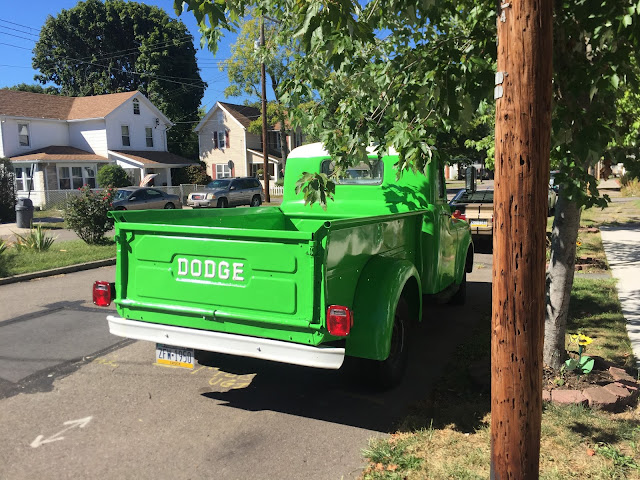GREEN DODGE GREEN TRUCK GREEN
I was exploring central PA when I was blinded by a nuclear lime vision:
This is a 1952 Dodge B-Series Truck in OH-MY-GOD-COULD-IT-GET-ANY-GREENER Green. There was a light pastel color choice called Silhouette Green but it was nothing like this.
This center breastplate that says Job-Rated was originally plain metal (I believe). The lettering in stamped into the surface and would have been filled in with red. The vertical green bars above and below those words were black. These lend themselves to backyard customization by restorers so well that they usually end up painted whatever color catches their fancy.
The B-Series was introduced in 1948 to replace the pre-war designs that had carried Dodge into and out of WWII. The hood is still the old design where each side opens up on a central hinge. That tall cab with the generous amount of glass was known as the Pilot House.
If you can look past the color it's easy to see this as a simple beast. The bed looks like some cobbled together homemade item tacked on to the back of a truck. In many ways that's how it was; the cab and drivetrain attached to a frame were the same across the board. However you could've purchased this with a dump truck bed, no bed at all, or even a van or woodie rear body.
I like the wheels which are good and honest originals. I'd love to have seen this before the paint.
That Mustang II will have to wait for another post as I snapped plenty of pics.
The taillights are in the original location but they were small circular versions from the factory. These are definitely '70s/'80s GM truck taillights which must make the Dodge bristle.
The tailgate is as basic as it looks; unlatch the top corners and it folds down on that metal bar at the bottom. Zero though was given to the beauty of the truck bed. This is a utilitarian appliance.
There were optional quarter windows you could've gotten on the corners of the Pilot House. They were smaller than the others but afforded almost 360 degree visibility.
Well there we have it. This was parked across the street from an ice cream parlor on a bright summer day so I couldn't take snaps of the interior. I'm pretty sure this was strategically placed across from the parlor and it totally looked the part. You can find these roosting in fields all across America just waiting to be woken up and put back to work.
Happy New Year!





















































